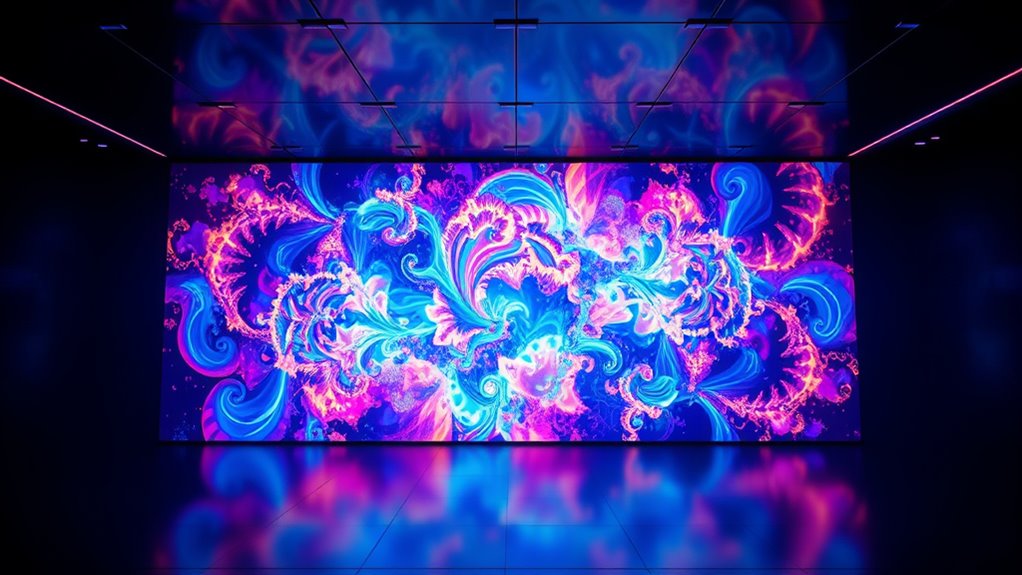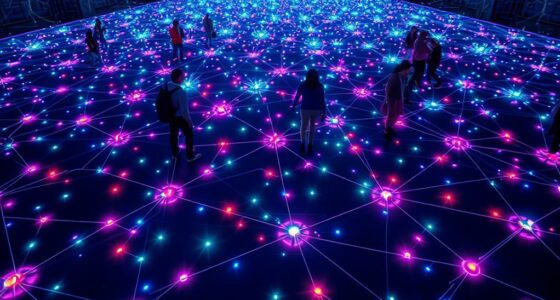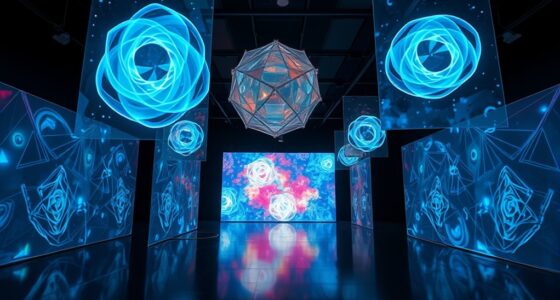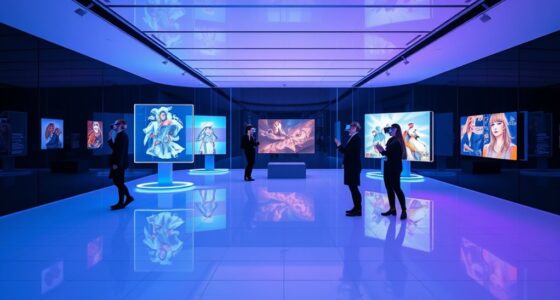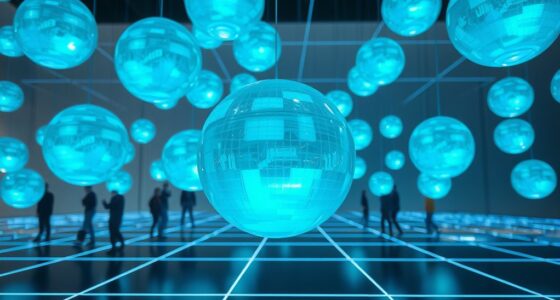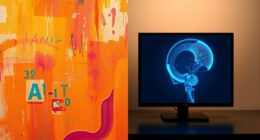The rise of generative art shows how algorithms and autonomous systems now craft stunning, original visuals and sounds that challenge traditional ideas of creativity. You see artists blending code, randomness, and complexity to produce unpredictable, mesmerizing works. These technologies expand artistic boundaries, creating new roles for humans and machines to collaborate. If you explore further, you’ll discover how innovation continues to reshape art’s future and its cultural significance.
Key Takeaways
- Generative art uses algorithms and autonomous systems to produce unique and complex visual or auditory creations.
- Advances in AI and coding enable rapid, iterative experimentation, expanding artistic possibilities.
- The integration of technology challenges traditional notions of authorship and creativity in art.
- Algorithms incorporate chaos, randomness, and complexity to generate unpredictable, captivating works.
- The rise of digital tools fosters collaboration across disciplines, shaping new aesthetic and cultural norms.
Understanding Generative Art and Its Foundations

Have you ever wondered how art can be created autonomously without direct human hands? Generative art involves using systems that generate artwork independently, often through predefined rules or algorithms. This can include visual art, music, or literature, where the system’s decision-makers—rather than a person—drive the process. The key feature is autonomy: minimal human intervention during creation, with outcomes influenced by chance or randomness. Historically, it dates back to mid-20th century pioneers like Georg Nees, who explored mechanical and computational methods. Over time, advances in technology expanded possibilities, incorporating mathematical, biological, and mechanical systems. Today, generative art challenges traditional notions of authorship and creativity, opening new frontiers for artists to experiment with automated processes and complex, emergent results. Understanding generative art highlights how algorithms can produce unique and unpredictable visual or auditory experiences that push the boundaries of conventional art forms. Additionally, the development of computational techniques has significantly broadened the scope and complexity of generative projects, allowing for more intricate and sophisticated outputs, especially through algorithmic processes. Moreover, the integration of artificial intelligence is further transforming the landscape by enabling systems to learn and adapt, resulting in even more dynamic and innovative artworks. The evolution of machine learning techniques continues to unlock new creative potentials in the field of generative art.
The Role of Algorithms and Code in Creative Expression

Algorithms and code have become powerful tools for expressing creativity, allowing you to generate complex and novel works beyond traditional methods. By coding, you transform abstract ideas into dynamic art forms that respond and evolve in real time. This fusion of technology and artistry expands your creative possibilities and reshapes how you define artistic expression. Additionally, predictive analytics can be employed in generative art to forecast emerging trends and inspire innovative designs. The integration of scientific principles ensures that these digital creations can also be grounded in a deeper understanding of material behavior and aesthetic harmony. Drawing inspiration from the mechanics of arcade machines, such as coin-operated mechanisms, can inform the development of interactive digital art experiences that engage audiences in novel ways. Incorporating tuning techniques from automotive customization demonstrates how precise adjustments and optimization can inspire sophisticated digital artworks that push boundaries. Developing cultural intelligence can further enhance your ability to create culturally resonant digital art that appeals to diverse audiences.
Algorithmic Creativity Unleashed
The integration of code and computational processes has revolutionized creative expression, enabling you to push beyond traditional boundaries. Algorithms mimic human creativity through complex instructions, generating outputs that feel novel, valuable, and surprising. Here are three ways they *release* creativity:
- Data-Driven Art: Algorithms analyze vast datasets to produce original images, music, or literature, expanding your creative palette.
- Collaborative Tools: They serve as advanced assistants, augmenting your ideas with speed, scalability, and fresh perspectives.
- Iterative Refinement: Dynamic feedback loops allow algorithms to improve outputs continuously, pushing your work into new territories.
- Design Integration: Algorithms can also assist in aesthetic decisions, such as color schemes and decor arrangements, which can be inspired by design principles from interior design.
Coding as Artistic Medium
Coding has become a powerful artistic medium, transforming how creators express ideas and emotions through digital forms. You can use algorithms as both the process and material of art, generating visual, sonic, and mechanical works. Programming enables complex patterns, generative art, and dynamic animations that go beyond traditional static pieces. Languages like JavaScript and CSS allow you to craft photorealistic or abstract digital artworks easily. Creative coding promotes rapid experimentation, helping you evolve your aesthetics continuously. Interactivity is often integrated, engaging audiences through motion tracking or real-time responses, making art a shared experience. Collaboration across disciplines, open-source tools, and data integration further expand your creative possibilities. Coding empowers you to manipulate media and data, blending technology with artistic expression in innovative and accessible ways. Additionally, understanding AI security vulnerabilities can inform safer implementation of generative algorithms to prevent misuse or bias in AI-driven art, which is essential for maintaining ethical standards in digital creativity. Moreover, being aware of relationships and personality dynamics can help artists create more emotionally resonant and socially conscious works.
How Autonomous Systems Transform Artistic Boundaries
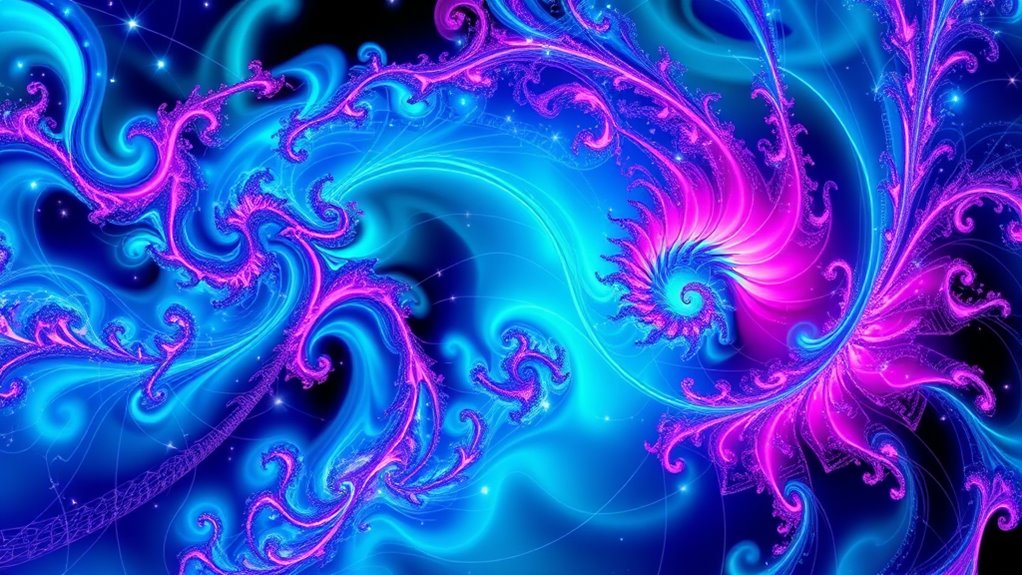
Autonomous systems change who holds artistic authority, shifting it from individual creators to algorithms and collaborative processes. They open up new creative possibilities that weren’t possible with traditional methods, encouraging experimentation and organic forms. As a result, these systems challenge conventional ideas of authorship, prompting you to rethink what it means to be an artist. Generative art enables rapid exploration of thousands of ideas within milliseconds, making the creative process more dynamic and unpredictable. Developing ethical hacking around these emerging technologies can help artists navigate the evolving landscape of digital creativity effectively. Additionally, integrating AI-powered virtual reality in e-learning can inspire new immersive art experiences that push creative boundaries.
Redefining Artistic Authority
As autonomous systems increasingly participate in the creative process, they reshape longstanding ideas about artistic authority. You now share the space with machines capable of generating original, valuable art independently. This shift challenges traditional notions of authorship and control, prompting you to reconsider your role. Consider these key points:
- Autonomous systems blur the line between human-made and machine-made art, creating hybrid forms that redefine classification.
- Your influence extends beyond direct creation—you act as a curator or director, guiding AI in co-creating works.
- Questions around authorship, ownership, and creativity surface, requiring new frameworks to understand agency in AI-generated art.
- The integration of automotive tuning techniques, such as ECU remapping and suspension modifications, exemplifies how technology reshapes creative possibilities across fields, including art. Recognizing the technological influence on creative domains can foster more innovative collaborations.
- Understanding support hours for related digital tools and platforms can help artists and developers maintain continuous engagement with their creative systems, ensuring smoother workflows.
This evolution encourages a collaborative view of artistic authority, emphasizing systems and networks over individual control.
Expanding Creative Possibilities
Generative systems serve as powerful creative partners, blending randomness with structured rules to produce one-of-a-kind artworks. You can explore diverse art forms, from visual pieces to music and literature, expanding your creative reach. Autonomous systems like neural networks generate art without direct human input, pushing boundaries and opening new possibilities. This approach, rooted in practices from the 1960s and revitalized by AI advances, democratizes art creation—making tools accessible to artists of all backgrounds. You’ll find that algorithms enable infinite variation, allowing you to experiment with new aesthetics and data-driven concepts. Interactive and evolving, generative art responds to viewers and environments, transforming how you conceive and share your creative ideas. This fusion of technology and artistry broadens the scope of what’s possible in your creative journey.
Challenging Traditional Authorship
The rise of AI-driven art is reshaping how we define authorship, challenging traditional legal and creative boundaries. You face questions like:
- How do we protect AI-generated works when there’s no clear human creator?
- Can AI and human collaborators be considered co-authors?
- Who holds legal rights when algorithms produce original art independently?
These issues complicate copyright laws that require human input. Legal cases like *Andersen v. Stability AI* highlight disputes over unauthorized use of copyrighted works. As AI systems develop autonomy, they blur the line between human and machine creativity, forcing us to reconsider what constitutes authorship. The evolving landscape demands new regulations that acknowledge AI’s role, redefining the boundaries of ownership and creative control in art.
Exploring Themes: Chaos, Randomness, and Complexity

Exploring themes like chaos, randomness, and complexity reveals how they intertwine to shape generative art. Chaos theory shows how small initial differences can lead to vastly different outcomes, creating intricate patterns like strange attractors and fractals. You harness this sensitivity to craft unpredictable yet structured visuals. Randomness introduces variability, making each piece unique, while artists control its influence through stochastic processes to maintain intent. Complexity arises from interconnected systems that interact dynamically, producing emergent behaviors and evolving patterns over time. Algorithms serve as your tools to embed chaos, randomness, and complexity into your work, generating unpredictable, enthralling results. Together, these themes push the boundaries of artistic creation, revealing the beauty hidden within complex systems and the power of mathematical unpredictability.
The Artistic Dialogue Between Human and Machine
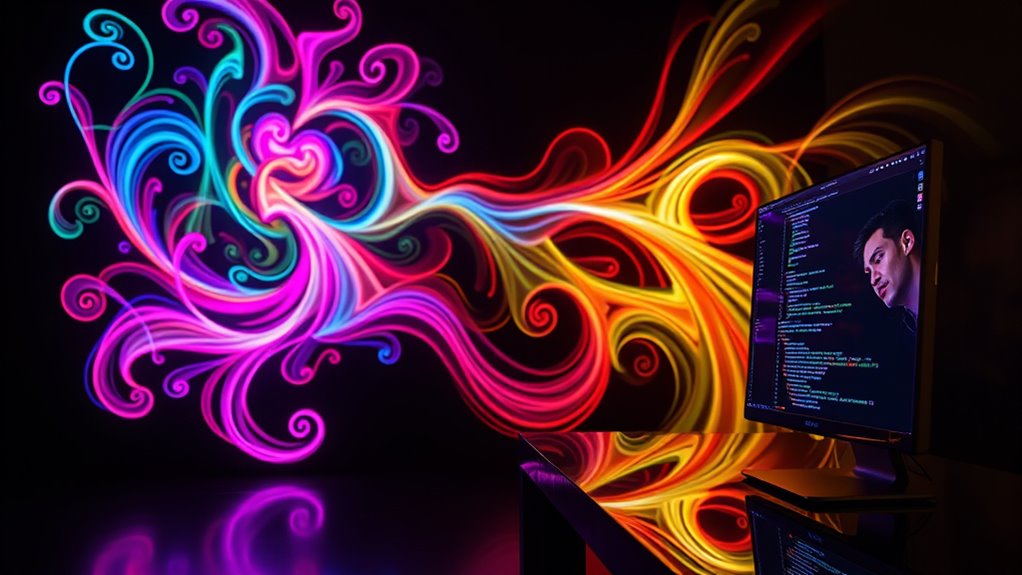
As technology advances, human and machine collaborate in ways that challenge traditional notions of artistic authorship. You become part of a dynamic dialogue, where creativity flows between human intuition and machine precision. This interaction produces unique outcomes that push boundaries. Consider:
- Blended Contributions: Human ideas guide AI-generated visuals, merging intuition with algorithms.
- New Forms of Expression: Robots and AI introduce embodiment, improvisation, and memory into art, expanding possibilities.
- Challenging Authorship: Questions arise about who owns the work—creator or collaborator—prompting a reevaluation of artistic agency.
Together, you and the machine co-create, transforming art into a conceptual dialogue that redefines what it means to be an artist. This partnership sparks innovation, blending human emotion with machine logic.
Cultural Shifts and the Redefinition of Creativity
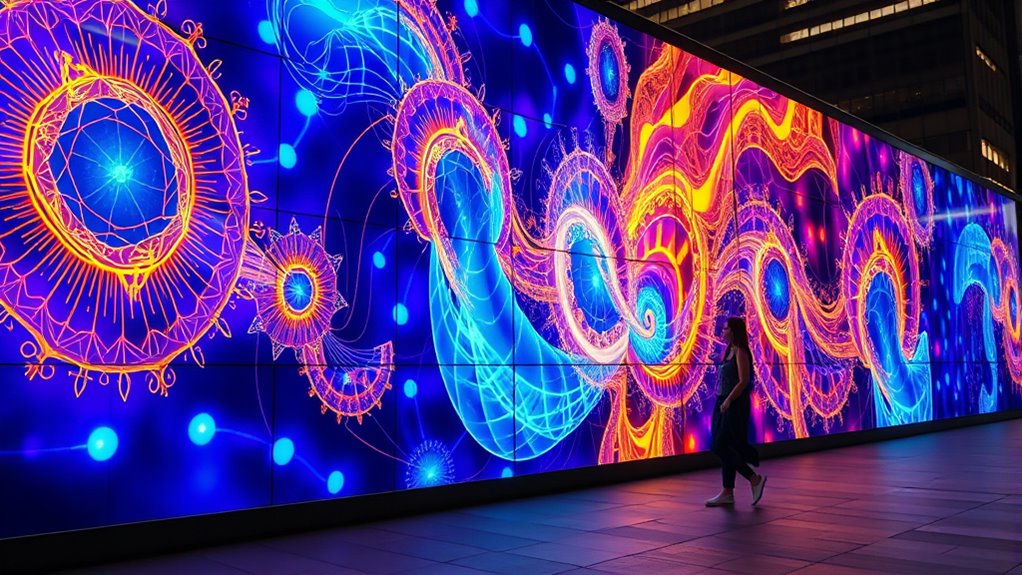
Generative art is reshaping cultural norms and challenging traditional ideas of creativity by integrating advanced technology into artistic practices. You may notice that public perception varies; 61% of U.S. adults don’t view AI-generated images as art, yet nearly half of Millennials believe they should. This divide reflects evolving social norms where technology influences cultural values, transforming how art reflects its time. Artists now incorporate algorithms, physics, and statistics into their work, expanding creative possibilities beyond traditional methods. Over 92% of artists feel they influence AI-created pieces, enhancing productivity and value. As generative art becomes a movement rather than a trend, it prompts society to reconsider what constitutes authentic creativity, blending human input with machine intelligence and reshaping cultural definitions across generations.
Technological Innovations Shaping the Future of Generative Art

Technological innovations are rapidly transforming the landscape of generative art, enabling you to push creative boundaries further than ever before. New models like Veo 3 and Imagen 4 deliver stunning improvements in generative capabilities, allowing you to create more complex and realistic visuals. Future AI models will handle intricate tasks like composing symphonies or generating photorealistic animations, expanding your artistic toolkit. Increased accessibility means you can now use advanced AI tools more easily, boosting your productivity and creativity.
Technological innovations are revolutionizing generative art, expanding creative possibilities with advanced models and seamless AI integration.
Here are three key innovations shaping the future:
- Cutting-edge models enhancing creative output
- Seamless integration into workflows for real-time collaboration
- Growing commercial applications, opening new markets and opportunities
The Growing Market and Societal Impact of Algorithmic Creations

The market for algorithmic art is experiencing rapid expansion, driven by increasing investment, innovation, and adoption across various industries. This growth is reflected in projections showing the global generative AI market reaching nearly USD 66.89 billion by 2025 and the art sector alone hitting USD 5 billion by 2025. As AI startups, communities, and industries embrace these tools, opportunities for artists and businesses multiply. AI-generated art is now prominent in media, entertainment, and interior design, boosting productivity and market diversity. Public exhibitions and social media further democratize art creation, fostering new cultural dialogues. The table below highlights key market drivers and projections:
| Year | Market Size | CAGR |
|---|---|---|
| 2024 | USD 0.43B | — |
| 2025 | USD 0.62B | 42.4% |
| 2029 | USD 2.51B | 42.0% |
| 2033 | USD 255.8B | — |
Envisioning the Next Era of Artistic Evolution
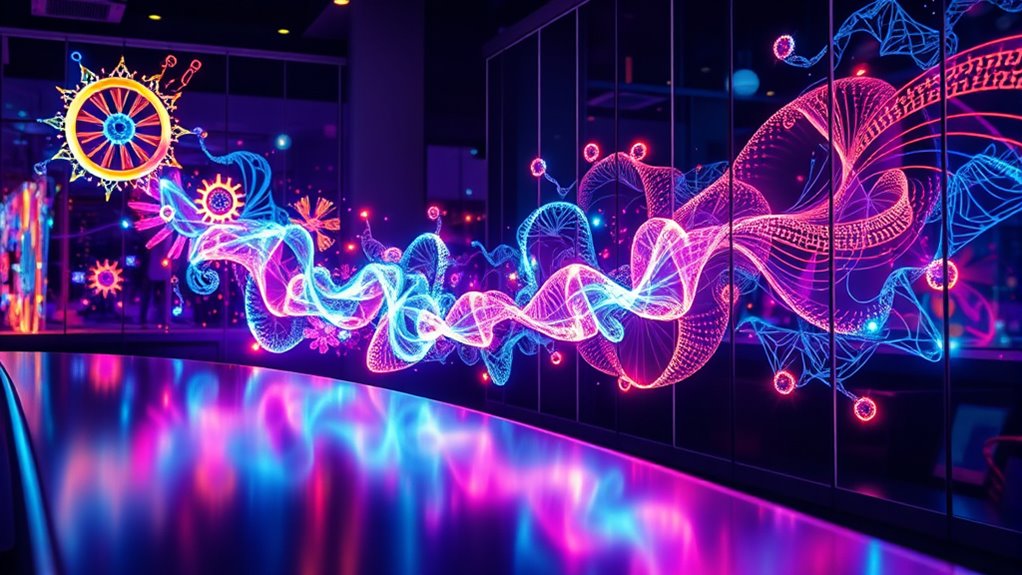
As artists and audiences alike explore new ways to create and experience art, a shift towards more human-centered and immersive approaches is shaping the future of artistic evolution. You’ll see a focus on bespoke design that highlights human uniqueness, blending traditional techniques like hand-painted styles with digital work. Maximalist approaches celebrate individuality and craftsmanship, emphasizing creative skill. Collaboration tools like Figma and AI platforms such as Adobe’s Concept AI enable artists to generate, refine, and share work seamlessly, even remotely. Meanwhile, immersive experiences powered by AI and AR push boundaries, creating surreal and interactive environments. These innovations challenge old paradigms, merging art and technology to foster unprecedented experimentation, accessibility, and new artistic forms. The future promises a richer, more personalized, and immersive creative landscape.
Frequently Asked Questions
Can Generative Art Be Considered Truly “Original” or Is It Derivative?
You might wonder if generative art can be truly original or just derivative. While algorithms draw from existing data, they can produce unexpected combinations that feel fresh. However, since AI relies on past inputs, some argue it’s more about remixing than creating anew. Ultimately, whether it’s original depends on your view of creativity—seeing innovation in new blends or recognizing the limits of algorithmic replication.
How Do Artists Retain Creative Control Over Autonomous Algorithmic Processes?
You can retain creative control over autonomous algorithms by setting clear parameters and choosing initial conditions, but also by embracing unpredictability as part of your process. Adjust randomness and noise levels to influence outcomes, and intervene when necessary. Collaborate with the algorithm, guiding its evolution while allowing room for surprises. This balance keeps your artistic vision intact, letting technology enhance, rather than replace, your creative expression.
What Ethical Concerns Arise From Ai-Generated Artworks?
You’re walking a tightrope when it comes to AI-generated art. Ethical concerns include lack of transparency about data sourcing, which can feel like pulling the wool over your eyes. Artists worry about their work being used without permission, and biases may perpetuate stereotypes. You also face questions about fair compensation and credit. Managing these issues requires careful thought, as the stakes are high for both creators and society.
Will Generative Art Replace Traditional Human-Made Art Forms?
You might wonder if generative art will replace traditional art forms. While algorithms can create stunning, complex pieces, they lack the personal touch, emotion, and cultural depth that human artists bring. You’ll find that both styles can coexist, each offering unique value. Instead of replacement, generative art complements traditional methods, expanding creative possibilities and inviting new ways for you to explore and express your artistic vision.
How Accessible Are Tools for Emerging Artists to Create Generative Art?
Tools for creating generative art are like open doors, welcoming emerging artists with ease. You’ll find platforms like RunwayML and GAN Paint Studio offering user-friendly interfaces, often free or affordable. You can work offline, customize models, and tap into vibrant communities for support. With regular updates and open-source options, you have everything needed to explore your creativity without breaking the bank, making art creation more accessible than ever.
Conclusion
As you step into this new era of art, it’s like entering a vast, uncharted landscape painted by algorithms, where creativity flows freely between human intuition and machine precision. Embrace the chaos and beauty they conjure, for together, you and the algorithms are shaping a future where art is limitless and ever-evolving. This dance of code and imagination promises a vibrant horizon, bursting with colors only possible through this digital renaissance.

